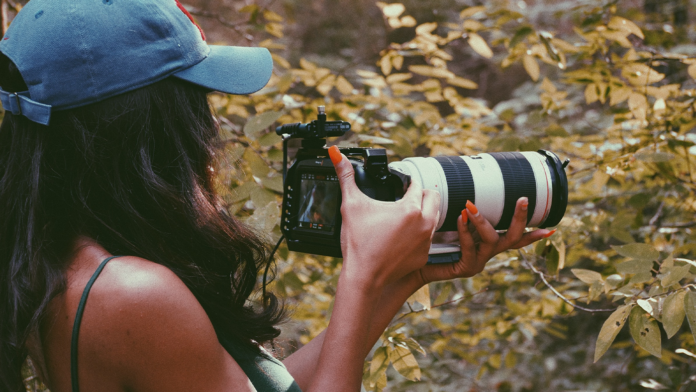In a nutshell
- Mastering basic camera movements like pan, tilt, and pull-back shots and understanding their emotional impact is a fundamental step in becoming a better videographer.
- Lighting, particularly mastering the three-point lighting setup, is crucial to ensure good video image quality, which is just as, if not more, important than the camera you use.
- Utilizing various focal lengths, understanding their impact on the shot’s aesthetic and exploring their influence on depth of field and distortion are key to shaping the look of your video content.
In this age of online media, there’s high demand for proficient videographers. It might seem like everyone with a smartphone can become a cinematographer, yet mastering the art of video demands a profound understanding of specific tools, practices and techniques.
This article aims to unveil the fundamentals of videography and offers six fundamental exercises to help you elevate your videography skills. Let’s get started.
Exercise 1: Master basic camera movements
Successful filmmakers should know when to move the camera or when to keep it stationary. They should also recognize how these decisions can communicate various emotions. They must also be familiar with traditional camera movements. Here’s an exercise to get you started with basic camera movements
Steps:
- Start with pan shots: Set up your camera on a tripod at a location with a wide view (like a park or a cityscape). Try to move the camera horizontally from one side to another while keeping its base stationary. Practice this movement multiple times until you can move the camera smoothly without any jerks. Remember, the speed of your pan can evoke different emotions. A slower pan can give a sense of calm, while a fast pan can imply action or chaos.
- Move on to tilt shots: After getting down the pan shot, try practicing the tilt shot. Keep the camera on the tripod and move it vertically up and down. Start with a wide shot and slowly tilt the camera down to a specific point, or vice versa. Practice this movement until it becomes second nature. See the video below for more info on the title shot.
- Next, practice push-in and pull-back shots: Once you’re comfortable with pan and tilt shots, move on to the push-in and pull-back shots. These are a bit more complex as they involve moving the camera towards or away from the subject. For a push-in shot, start with a wider frame and slowly move the camera closer to the subject. For a pull-back shot, do the reverse. These shots can create a sense of motion and reveal or hide details in a scene.
- Now combine movements: After you’ve practiced these movements separately, try combining them. For example, you can start with a tilt, then pan and then a pull-back shot. This combination can create a dynamic and visually interesting shot.
- Review and critique your video: After each shooting session, review your footage. Pay attention to how smooth your movements are and whether you were able to capture the emotion you intended. Make notes of areas that need improvement and focus on those in your next practice session.
Exercise 2: Practice the three-point lighting setup
Next up, we have lighting. Lighting is just as important, if not more important, than the camera you use. Nailing your lighting will ensure that your video’s image quality is good — and the best one to start with is the three-point lighting setup. Let’s practice the three-point lighting setup:
Steps:
- Key light: Begin in a dark environment and introduce your key light as your first light source. Position this light at a 45-degree angle off to the side to light up the front of your subject’s face. This should be the strongest light source in your setup.
- Fill light: Next, introduce the fill light on the opposite side of the key light. This light should be less intense than the key light, and its purpose is to soften the shadows created by the key light, adding depth to your subject.
- Back light: Position the back light at a 45-degree angle behind your subject. This light will illuminate the back of your subject’s head and shoulders. Back lights help to separate them from the background — giving your video a more three-dimensional look.
- Experiment: Experiment with different light sources. Natural light can be an effective substitute if studio lights are unavailable. Be creative with your light sources; consider using windows for natural light or lamps for indoor shots.
- Review: Review your footage. Look at how the light and shadows work together to give your subject a three-dimensional look. Make a note of what worked and what didn’t, and adjust your lighting setup accordingly next time.
3. Understand and utilize simple composition and framing techniques
Developing a keen eye for composition and framing is integral to producing visually compelling videos. The following exercise is designed to help you practice basic composition and framing techniques, focusing on different types of shots and the application of the rule of thirds.
Steps:
- Close-up shots: Start by capturing a close-up shot of your subject. This shot should tightly frame the subject’s face, capturing details that allow for an emotional connection with the audience. Use a lens between 50 mm and 100 mm for best results.
- Other shots: Next, experiment with other types of shots, such as the establishing shot, long shot and medium shot. Each shot offers a different perspective and level of detail, and understanding when to use each one is crucial to effective storytelling.
- Rule of thirds: Apply the rule of thirds to your shots. Imagine your frame divided into nine equal parts by two equally spaced horizontal lines and two equally spaced vertical lines. Position your subject along these lines, or at the points of intersection, for a balanced and engaging composition.
- Experiment with your videos: Mix and match the different shot types with the rule of thirds. For instance, you might try a close-up shot with the subject’s eyes aligned with the top horizontal line or a long shot with the subject placed at one of the points of intersection.
- Review your video: Review your footage. Assess how well you used the different framing shots and the rule of thirds in your compositions. Make note of what worked and what didn’t, and apply those insights to your next session.
4. Learn and experiment with depth of field
Depth of field refers to the range of focus in your shot, extending from the nearest object in focus to the farthest. It’s influenced by three factors: aperture, distance to the subject and the focal length of your lens. It’s important to practice these factors. Here’s how:
- Understanding aperture: Set your camera to a wide aperture setting (e.g., f/1.8). Focus on your subject, and note how the background becomes blurry, creating a shallow depth of field.
- Adjusting aperture: Adjust the aperture to a smaller setting (e.g., f/18). Notice how the depth of field widens, keeping both the subject and background in focus.
- Experimenting with distance: Experiment with changing the distance to your subject. Start close to your subject, then gradually move farther away. Observe how the depth of field changes — it’s shallower when you’re closer and wider when you’re farther away.
- Exploring focal length: Try out different lenses with various focal lengths, if available. Note how longer focal lengths create a shallower depth of field while wider lenses keep more elements in focus.
- Practicing: Continue to practice with different aperture settings, distances, and focal lengths. This will help you understand how each of these factors influences the depth of field and how they can be combined for the desired effect.
5. Explore different focal lengths
The focal length of your camera lens can shape the aesthetic of your shot by creating depth of field and distortion. Focal length is a measurement related to the optical power of the lens, describing how magnified it is. Focal lengths range from 18 mm, 24 mm, 35 mm, 50 mm, 70 mm, to 100 mm. These exercises will help you practice shooting with different focal lengths.
Steps:
- Understand focal lengths of video: First, familiarize yourself with the various focal lengths and their impact on your images. For instance, 16 mm provides a broad view and is less magnified in contrast to 100 mm, which offers a more focused and magnified view. If you have camera lenses on hand, determine their focal lengths.
- Identifying lens type: Determine if your lens is a prime lens with a fixed focal length or a zoom lens that allows adjustment of the focal length. Recognize that prime lenses tend to produce sharper images, while zoom lenses offer more flexibility in framing your shots without changing the lens.
- Shooting video with a wide lens: Begin shooting with a wide lens, for instance, a 24 mm lens. Observe the extent of the background captured in your shot and the depth of focus you achieve.
- Switching to a longer lens: Switch to a longer lens, like 100 mm, for close-ups. Observe the compression of the background and the increase in out-of-focus areas, which creates a shallower depth of field.
- Comparing focal lengths: Compare the effects of using different focal lengths on your shots. The aim is to understand how lens choice affects your video’s aesthetic.
6. Practice basic visual storytelling
Aaron Sorkin, a renowned screenwriter, once said, “The most important thing in drama is intention and obstacle. Without that, you don’t have drama.” Visual storytelling should focus on character, want and need, plot, structure, conflict and resolution. These are also the key components of a successful narrative arc. Here, we would like you to develop a short scene without dialogue. This way, you will learn the tools you have as a visual storyteller.
Steps:
- Choose a protagonist: Begin by identifying your main character and understanding their wants and needs. It’s crucial to have a clear idea of your protagonist’s motivations and desires.
- Create an obstacle: Develop an obstacle that prevents your protagonist from achieving their desires or fulfilling their needs. The more significant the obstacle, the more engaging the drama.
- Add another character: Introduce a secondary character to the narrative to enhance its complexity and depth. Ensure this character adds something meaningful to the plot.
- Incorporate additional obstacles: Develop an obstacle that your protagonist must confront. These should escalate the drama and add complexity to the narrative.
- Utilize camera techniques: Use a range of camera movements, lighting techniques and framing strategies to enhance the visual storytelling of your scene.
Keep improving
By following these six exercises, you’ll not only improve your technical videography skills but you’ll also enhance your storytelling abilities. This can help you to stand out in the increasingly competitive field of videography. Always remember, the best camera is the one in your hands. So, get out there and start shooting.








